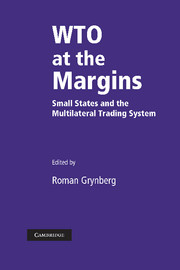Book contents
- Frontmatter
- Contents
- List of figures and appendices
- List of tables
- List of contributors
- Introduction
- Part I Theory and evidence
- Part II WTO and small economies
- Part III WTO dispute settlement
- 11 Small states in the banana dispute
- 12 Impact of changes in the European Union's policy for banana imports on the Eastern Caribbean Region (1992–2002)
- 13 Jamaica and the case in the WTO against the European Communities regime for the importation, sale and distribution of bananas (1992–2001)
- 14 WTO complaints by Australia and Brazil regarding the EU sugar regime
- 15 Reform of EU export subsidies on sugar: the legal and economic implications for the ACP countries
- 16 Analysis of the impact of opening up the EU import market for canned tuna on ACP countries
- Part IV Negotiating issues and institutional arrangements
- Index
12 - Impact of changes in the European Union's policy for banana imports on the Eastern Caribbean Region (1992–2002)
Published online by Cambridge University Press: 05 May 2010
- Frontmatter
- Contents
- List of figures and appendices
- List of tables
- List of contributors
- Introduction
- Part I Theory and evidence
- Part II WTO and small economies
- Part III WTO dispute settlement
- 11 Small states in the banana dispute
- 12 Impact of changes in the European Union's policy for banana imports on the Eastern Caribbean Region (1992–2002)
- 13 Jamaica and the case in the WTO against the European Communities regime for the importation, sale and distribution of bananas (1992–2001)
- 14 WTO complaints by Australia and Brazil regarding the EU sugar regime
- 15 Reform of EU export subsidies on sugar: the legal and economic implications for the ACP countries
- 16 Analysis of the impact of opening up the EU import market for canned tuna on ACP countries
- Part IV Negotiating issues and institutional arrangements
- Index
Summary
Introduction
Ever since the demise of sugar as a major export crop from the Windward Islands to the United Kingdom in the 1950s, bananas have assumed prominence as the only viable export alternative. Yet, the viability of exporting Windward Islands bananas to the United Kingdom has been directly linked to the preferential market access that they enjoy, i.e. tariffand quota-free market access. Preferential market access for bananas to the European Community (EC) had in fact been secured for all African, Caribbean and Pacific (ACP) countries since the signing of the Treaty of Rome in 1957. At the signing of the Treaty of Rome, EC Member States had agreed that a tariff and, optionally, a quota would apply with respect to other banana imports. In practice, these sources of other banana imports were largely a few countries in Central and Latin America, from where a number of United States based transnational corporations (TNCs) operated, the so-called dollar zone countries. A notable exception to the generally agreed scheme of granting preferential market access was found in Germany, where, under a special protocol annexed to the Treaty of Rome, Germany had secured the right to import nearly all its bananas from dollar zone sources free of duty and taxes. Germany had won the right to this special protocol given that it was the largest single consumer of bananas in Europe at the time, and that it had traditionally sourced all its imports from the dollar zone.
- Type
- Chapter
- Information
- WTO at the MarginsSmall States and the Multilateral Trading System, pp. 451 - 483Publisher: Cambridge University PressPrint publication year: 2006



